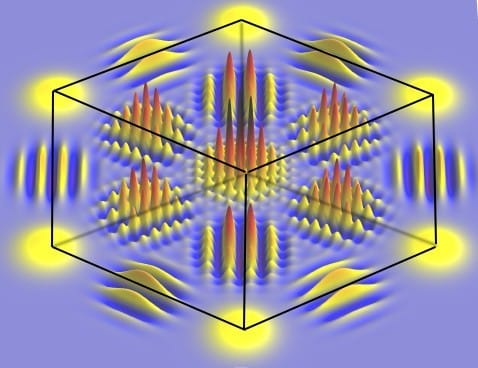
Schrödinger’s cat is a term from quantum physics. It is synonymous with atomic states which are used in the development of quantum technologies. Now a research team has discovered a new kind of quantum state. They are multidimensional hypercube cubes that can be used for highly sensitive quantum sensors.
The differences between quantum physics and classical physics on a microscopic scale are particularly evident – for example in the structure of atoms and molecules. Atoms follow their own laws and cannot be defined by the rules of classical physics.
Schrödinger’s cat is a conceptual experiment formulated in 1935 by the scientific theorist and founder of quantum mechanics, Erwin Schrödinger. These are states of very small particles that have two states, so-called quantum superpositions. The two states are complementary and overlap each other. It is only after an observation or a measurement that a particle is able to be perceived in a certain state. An observation must be made of an interaction that the particle has had with the environment, in order to acquire information about it. As long as we are not observing the particle, we cannot tell what state it is in.
Quantum state: Superposition
Schrödinger describes the particle as a cat in a closed box containing a vial of poison. If the cat succeeds in opening the vial, it dies, if it does not succeed, it remains alive. As long as the cat is not observed, it is dead and alive at the same time. In order to determine its condition, the box must be opened.
Building block of Quantum technology
Schrödinger created with his cat an important building block for modern quantum technologies. But since 2001 this is no longer the only one. At that time another superposition was discovered in the form of the so-called compass state. This does not consist of two, but rather of four classical states, which are arranged like the main directions of a compass.
Researchers worldwide are working on simulating these building blocks within quantum systems such as individual atoms or light particles. This includes an international team of physicists from Austria, Australia and the United Kingdom who are all striving towards the development of quantum sensors.
Limitations of accuracy
Quantum sensors have the potential to perform much more precise measurements than comparable classical sensors. They are quantum mechanical effects that lead to inexhaustible accuracy levels, explains project leader Martin Ringbauer of the Institute of Experimental Physics at the University of Innsbruck. Quantum sensors have the potential to perform much more precise measurements than comparable classical sensors. However, if you try to make the distances between the measuring units increasingly smaller, you will sooner or later reach a quantum mechanical limit – the Heisenberg uncertainty principle, Ringbauer explains further.
The Heisenberg Uncertainty Principle states that two properties of a quantum object cannot be accurately determined simultaneously.
Quantum sensors, on the other hand, bypass the limitations of accuracy by using quantum mechanical properties such as superposition and entanglement.
” By placing a quantum system into such a superposition of two classical states, sensitive interference phenomena are formed that could be used in quantum technology.” Martin Ringbauer
The researcher demonstrates the system with the superposition of water waves, which occur when two stones are thrown into the water at the same time.
Multidimensional hypercube
In their experiments, the researchers discovered a new kind of superposition whose classical building blocks represent the corners of multidimensional hypercubes. The researchers worked with tiny membranes in order to develop states for novel quantum sensors whenever they encountered more or less by accident.
The quantum hypercube states seem particularly promising when it comes to the construction of novel quantum sensors. They are able to circumvent accuracy limits by taking advantage of quantum interference. “The example of the stones in the water shows that even large stones cause fine patterns in the superposition of the waves. These can be considerably smaller than the stones that trigger them, Ringbauer explains. The same applies to quantum states. The states at the corners of the multidimensional hypercube are admittedly only of a minimum size, yet nevertheless the interference patterns do become increasingly finer in relation to the dimension of the hypercube.

Above image: Hypercubic states consist of several quantum superpositions that represent the corners of multidimensional cubes.
Optical quantum sensors
At present, quantum sensors are still in the development stage. However, promising applications are already emerging. For example, optical quantum sensors can achieve higher accuracy with less light. This is particularly important for examinations of biological systems, such as living cells, which must be treated extremely carefully, Ringbauer says. One possible field of application is medical methods such as magnetic resonance tomography and ultrasound examinations.
This project has been supported by the Austrian Science Fund (FWF) and the European Union, among others. The article was published in the science journal Physical Review Letters.
Publication:
Quantum Hypercube States. L. A. Howard, T. J. Weinhold, F. Shahandeh, J. Combes, M. R. Vanner, A. G. White, and M. Ringbauer. Phys. Rev. Lett. 123, 020402
Also interesting:
Relationship discovered between quantum physics and spacetime
Physicists develop an interface for quantum computers
Precise simulation of complex quantum problems within reach
Quantum sensor for measuring light particles
Schrödinger’s cat learns to fly
